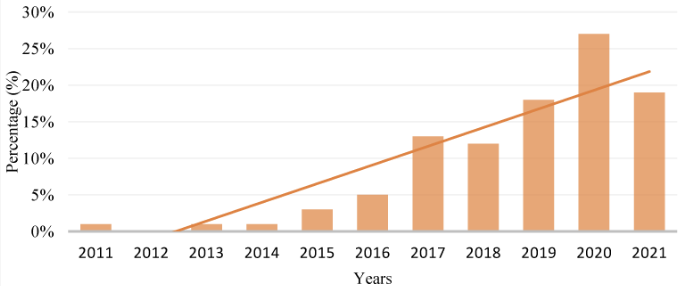Fused Deposition Modelling of Polymer Composite: A Progress
Author: Faiz Ahmad - December 2022
by J Mogan, W. S. W. Harun, K. Kadirgama, D. Ramasamy , F. M. Foudzi , A. B. Sulong , F. Tarlochan
Abstract
Additive manufacturing (AM) highlights developing complex and efficient parts for various uses. Fused deposition modelling (FDM) is the most frequent fabrication procedure used to make polymer products. Although it is widely used, due to its low characteristics, such as weak mechanical properties and poor surface, the types of polymer material that may be produced are limited, affecting the structural applications of FDM. Therefore, the FDM process utilises the polymer composition to produce a better physical product. The review’s objective is to systematically document all critical information on FDMed-polymer composite processing, specifically for part fabrication. The review covers the published works on the FDMed-polymer composite from 2011 to 2021 based on our systematic literature review of more than 150 high-impact related research articles. The base and filler material used, and the process parameters including layer height, nozzle temperature, bed temperature, and screw type are also discussed in this review. FDM is utilised in various biomedical, automotive, and other manufacturing industries. This study is expected to be one of the essential pit-stops for future related works in the FDMed-polymeric composite study.
Methodology
Composite materials have developed into engineering materials that are remarkable and diverse because they are strong in domain areas that do not deform easily and have a high strength-to-weight ratio [30,31]. A composite material is defined by its name, which implies that it is made of different materials. Compositional engineering occurs when many constituent materials with significantly different chemical or/and physical properties are combined to form a new material with unique characteristics that are not present in the individual element [32,33,34,35,36,37]. Compared to the qualities of individual materials, this augmentation makes composite materials preferable. There are different types of composite material: scale base composite, reinforced base composite, matrix material base composite, and bio-composite. Figure 3 summarises the types of composite material. A composite material comprises two materials, namely base and filler. Because it wraps and bonds the reinforcement of other materials, the base material is commonly known as a matrix or a binder material. Fibres, particles, fragments, and natural or synthetic whiskers are filler materials [38,39,40]. Matrix is a soft phase with mechanical and physical properties, such as formability, ductility, and thermal conductivity. Material with high stiffness, strength, and low thermal fluctuation is included in the matrix reinforcement. The reinforcement phase of composites is always stiffer and more robust than the matrix because it conveys the load applied to the material.
Impact & Benefits
Advancement in Manufacturing Technology: Discusses how AM, including FDM, represents a significant advancement in manufacturing by enabling affordable and efficient production of three-dimensional structures directly from digital designs. This transformation is critical in reducing lead times and costs associated with traditional manufacturing methods.
Diverse Applications Across Industries: Highlights the broad applicability of AM technologies in industries such as biomedical, aerospace, automotive, and textiles. This underscores AM's versatility in producing customized parts with complex geometries, catering to various industry-specific needs and requirements.
Cost-Effectiveness and Customization: Emphasizes the cost-effectiveness of FDM in particular, due to its lower operating and initial investment costs compared to traditional manufacturing techniques like injection molding. Additionally, AM allows for the fabrication of small quantities of customized parts without the need for specialized tools, thus reducing inventory costs and enabling rapid prototyping and manufacturing.
Materials and Composites Utilization: Explores the utilization of diverse materials such as metals, polymers, and composites in AM processes. Specifically discusses the enhancement of polymer properties through the addition of fillers, showcasing the potential for creating high-performance materials tailored to specific applications.
Challenges and Future Directions: Acknowledges current challenges in AM, including issues like dimensional accuracy, porosity, and layer adhesion in FDM. Despite these challenges, the article provides insights into ongoing research efforts aimed at improving process parameters and material properties to further enhance the reliability and performance of AM-produced parts.
Findings/Figures and Research Data
The findings from the article underscore the pivotal role of additive manufacturing (AM), particularly FDM (Fused Deposition Modeling), in revolutionizing industrial production. AM is recognized as a transformative advancement in the fourth industrial revolution, witnessing substantial adoption across various sectors. FDM emerges as the preferred AM method due to its ability to fabricate intricate designs cost-effectively compared to conventional manufacturing methods. The article discusses the detailed process flow of FDM and explores the properties of polymer composite materials, highlighting common base materials and fillers used. It identifies critical printing parameters such as nozzle temperature, bed temperature, printing speed, and layer height, emphasizing their significant impact on the performance of FDM-printed products. However, it notes a current limitation in understanding how these parameters influence mechanical behavior across different materials, indicating a need for further research. Despite its versatility, challenges remain in FDM, including issues like porosity, layer gaps, and visible raster lines, which constrain its application for large-scale production, especially when compared to established techniques such as injection molding.
Market Potential
The market potential for additive manufacturing (AM), particularly Fused Deposition Modeling (FDM), is vast and expanding rapidly across numerous industries. AM technologies like FDM enable cost-effective production of complex geometries and customized parts, which is advantageous in sectors requiring rapid prototyping and small-batch manufacturing. The ability to directly translate digital designs into physical objects reduces capital expenditure and transportation costs significantly. FDM's versatility in using various materials such as metals, polymers, and composites further enhances its applicability in diverse fields including biomedical, aerospace, and automotive industries. Despite challenges such as lower mechanical strength compared to traditional manufacturing methods like injection molding, FDM continues to evolve with advancements in materials and process optimization. The ongoing research and development in AM, especially in improving dimensional accuracy and material properties through polymer composites and other innovations, underscore its growing importance as a disruptive technology in modern manufacturing.



